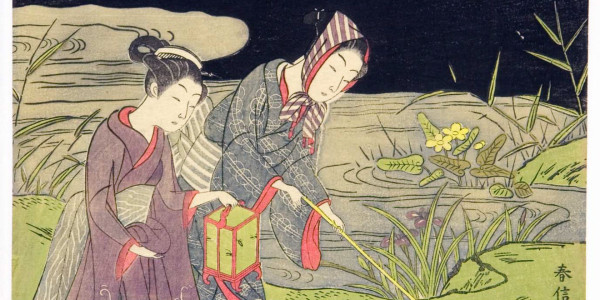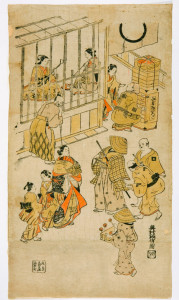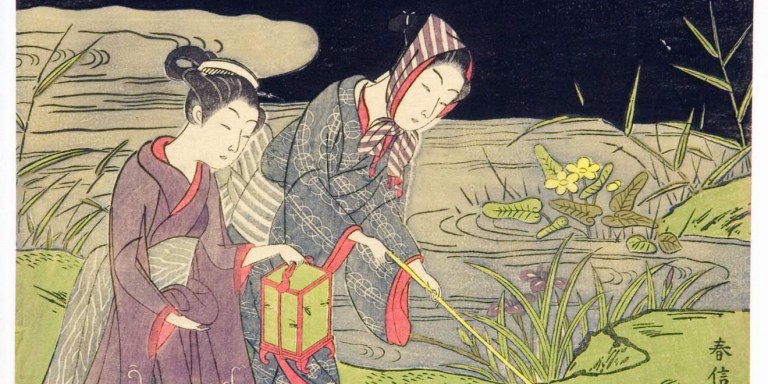
“The Printer’s Eye” showcases 88 ukiyo-e (“oo-kee-yo-eh”), or “pictures of the floating world” — that is, woodblock prints depicting scenes in the licensed red-light district of Edo (present-day Tokyo). These were assembled by Edwin Grabhorn (1889-1968), who was captivated by the innovative techniques of printmaking that emerged throughout the late 18th and early 19th centuries.
Ukiyo-e were originally made to celebrate and promote the pleasure-seeking way of life in Japan’s Edo period (1615–1868). Set against the backdrop of the city’s Kabuki theaters and the Yoshiwara — Japan’s most famous pleasure quarter — these prints featured the popular fashion trends of that season and the well-known geishas, sumo wrestlers, actors and prostitutes in the area. They were comprised of carefully orchestrated street scenes, dense full-length narratives and close-up intricate portraits and were sold at cheap prices by street vendors. Today, these prints have become priceless historical clues to the popular culture and public entertainments available to residents of Edo.
Artists paid particular attention to the seasons and festivals during printmaking, for these were times when customers were most generous with purchases. “Hunting For Fireflies” is a well-known piece by Suzuki Harunobu, an artist known for his innovative use of colors. The piece depicts a simply-dressed couple, hunting for fireflies during the firefly season in summertime. The woman is in a furisode, a type of kimono worn by unmarried women, while the man wears a robe with a kuruwa tsunagi design, a phrase that has the double meaning of both “joined curved circles” and “joined in the pleasure quarters.” The piece showcases a wide variety of colors, with a dark rich blue falling into the background and light lively colors in the foreground. Thin lines complement this lightness, almost allowing viewers to hear the soft tip-toeing of the couple.

“Street Scene In The Pleasure Quarters” is a brilliant hand-colored print by Okumura Masanobu. While it lacks the colors of “Hunting,” this piece is rich in content matter and brings out the bustling, festive mood in the Yoshiwara quarters. Behind the grill bars, the women play their instruments and smoke, arousing the attention of potential clients who fancy the thought of being connoisseurs of women. In the foreground, there is a courtesan whose high ranking can be guessed from her two child attendants and the classical Chinese calligraphy patterns of her robe. There is also a samurai, recognizable by the swords at his waist, attempting to conceal his identity with the tengai, the basket hat, for the Edo government discouraged the visiting of the pleasure quarters. Masanobu packs the scene with different characters, and the attention paid to the garments and posture makes the characters come alive.
“The Printer’s Eye” not only tells the stories in the Yoshiwara quarters but also traces the technical development of the ukiyo-e from its beginnings in monochromatic prints to when hand-colored prints emerged to its technical peak of complex designs also termed as nishiki-e, or “brocade pictures.” The show includes rare early works by Ishikawa Toyonobu, Okumura Masanobu, Suzuki Harunobu, Kubo Shunman and other innovative artists of the late 18th and early 19th centuries.
The show is a worthy reason for a visit up to the city, and students can bring their ID cards for a discount on the entrance fee. Alongside “The Printer’s Eye” is another thematic exhibition, “Seduction,” showcasing a larger diversity of art — kimonos, paintings and a 58-foot-long hand-scroll — also depicting life in the Yoshiwara quarters.
“The Printer’s Eye” is on view until May 10 at the Asian Art Museum.
Contact Bao Jia Tan at baojia ‘at’ stanford.edu.
